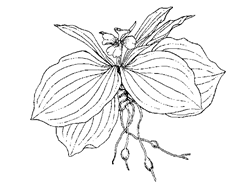
See also lesser and greater galangal (Alpinia galanga and A. officinarum).
Medicinal Uses (Galanga) —
Reported to be carminative, diuretic, expectorant, pectoral, pedicu-licide, stimulant, stomachic, and tonic. The rhizome, called “gisol,” has been used to treat sore throat. Philipinos use the plant for headache and parturition. They also mix the rhizome with oils as a cicatrizant, applying it to boils and furuncles. Bown (2001) recounts a mix of four ginger relatives (Alpinia, Curcuma, Kaempferia, and Zingiber) called “awas empas,” a Jamu remedy for headache, stiff joints, and UTIs.
Many zingiberaceous plants exhibit antitumor activities, over and beyond COX-2-Inhibitory and antimutagenic activities. Vimala et al. (1999) reported seven zingiberaceous rhizomes which inhibited EBV activation (induced by TPA): Curcuma domestica, C. xanthorrhiza, Kaempferia galanga, Zingiber cassumunar, Z. officinale, and Z. zerumbet. Lack of serious cytotoxicity led the authors to conclude that naturally occurring non-toxic compounds inhibited the EBV activation.
Pitasawat et al. (1998) screened ten carminative species and found larvicidal activity against Culex quinquefasciatus (exposing early fourth instar larvae to ethanolic extracts). They found significant larvicidal effects with Kaempferia galanga, Illicium verum, and Spilanthes acmella, which had LC50 values of 50.54, 54.11, and 61.43 ppm respectively. Chu et al. (1998) found that galangal extracts were amebicidal for three species of Acanthamoeba. The extracts induced encystment.
Indications (Galanga) —
Amebiasis (1; X9766904); Boil (f; CRC; DAA); Bruise (f; DAA); Cancer (1; JLH; X10389986); Childbirth (f; CRC; SKJ); Chill (f; CRC; DAA; WOI); Cholera (f; DAA); Cough (f; CRC; DAA; KAB); Dandruff (f; CRC; WOI); Dyspepsia (f; CRC; WOI); EBV (1; X10389986); Enterosis (f; DAA); Fever (f; CRC; WOI); Furuncle (f; CRC); Headache (f; CRC; WOI); Inflammation (f; CRC; WOI); Lameness (f; DAA); Lice (f; DAA); Lumbago (f; DAA);
Malaria (f; CRC; DAA; WOI); Myosis (f; DAA); Ophthalmia (f; CRC; WOI); Pain (f; DAA);
Parasite (1; X9766904); Rheumatism (f; CRC; DAA); Rhinosis (f; KAB); Scabies (f; CRC); Sore
Throat (f; CRC; DAA; WOI); Sting (f; WOI); Swelling (f; CRC; DAA; WOI); Toothache (f; CRC; DAA); Tumor (f; CRC; WOI); Virus (1; X10389986).
Other Uses (Galanga) —
An attractive spice plant used in various culinary applications, it is called “kencur” in Indonesia and “krachai” (“grachai,” “kachai”) in Thailand. The aromatic EOs of the roots are used widely in perfumery, as a condiment, and as folk medicine. In Java, the rhizomes of “kentjoor,” as it is called, are used in seasoning many dishes, especially rice dishes. The rhizomes are also pickled, or used to make “beras,” a sweet, spicy beverage. They are chewed with the betelnuts. A Javan beverage called “beras kentjoor” is made from the roots (Ochse, 1931). Dried rhizomes are used as a substitute for turmeric in curry powder (FAC). In Java and elsewhere in Asia, the galanaga is used, almost interchangeably, with the greater galangal. The galanga is a bit more pungent. One tsp powdered galanga is roughly equal, culinarily, and probably medicinally, to a quarter-inch (diameter) slice of the fresh rhizome or a one-eighth thick dried slice (length not mentioned). Leaves and rhizomes may be used in curries, eaten raw or steamed, or cooked with chili (FAC). The leaves of a narrow-leafed variety are also consumed as food. But leaves of all varieties may be used in lalabs. Asians employ the rhizomes and leaves as a perfume in cosmetics, hair washes, and powders. They are also used to protect the clothing against insects. More rarely it is said to be used as an hallucinogen.
For more information on activities, dosages, and contraindications, see the CRC Handtopic of Medicinal Herbs, ed. 2, et al., 2002.
Cultivation (Galanga) —
Seems to be cultivated in humid tropical Asia (zones 9-11), like several other members of the ginger family (Bown, 2001). Propagated by dividing plants in spring or sowing ripe seed at ca. 20°C (68°F). Pieces of the rhizome are planted in fertile, moderately drained soils, often at 40-60 cm a part, both ways, with interplants grown in between. In very rich soils they may be grown as a solitary crop, spaced closer at 15-25 cm apart. They are dug when the plant loses its leaves during the monsoon (to prevent its decay in the excessively humid soils).
Chemistry (Galanga) —
The EO contains n-pentadecane, ethyl-p-methoxycinnamate, ethyl cin-namate, carene, camphene, borneol, and p-methoxystyrene. Narcotic hallucinogen. Here are a few of the more notable chemicals found in galanga. For a complete listing of the phytochemicals and their activities, see the CRC phytochemical compendium, and , 1993 (DAD) and the USDA database.
Borneol — Allelochemic; Analgesic; Antiacetytlcholine; Antibacterial MIC = 125-250 ng/ml; Antibronchitic; Antiescherichic MIC = 125 ng/ml; Antifeedant; Antiinflammatory; Antiotitic; Antipyretic; Antisalmonella MIC = 125 | g/ml; Antispasmodic ED50 = 0.008 mg/ml; Antistaphylococcic
MIC = 250 | g/ml; Candidicide MIC = 250 | g/ml; Choleretic; CNS-Stimulant; CNS-Toxic;
Fungicide; Hepatoprotectant; Herbicide IC50 = 470 mM; IC50 = 470 \\M; Inhalant; Insectifuge; Irritant; Myorelaxant; Negative Chronotropic 29 | g/ml; Negative Inotropic 29 | g/ml; Nematicide MLC = 1 mg/ml; Sedative; Tranquilizer; LDlo = 2000 orl rbt.
Camphene — Antilithic; Antioxidant; Expectorant; Hypocholesterolemic; Insectifuge; Spas-mogenic.
Carene — Antibacterial; Antiseptic; Fungicide; Irritant; LD50 = 4800 mg/kg orl rat.
